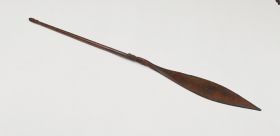Steering paddle hoe
Place: New Zealand
Category: Fishing & hunting
wood, New Zealand, l. 193 cm, w. 15.5 cm, Inv. Oz 285
Humphrey No. 231: ‘A paddle of a War Canoe of New Zealand, the middle part singularly carved.’
Wooden paddle of a war canoe. The shaft is decorated with ornaments at the handle and at the connection of the blade.
The use of the paddle was the usual means of canoe propulsion at the time of the first European discoverers. The simple paddles were mostly 120 to 150 cm long, the steering paddles being longer. Therefore, the above piece is presumably a steering paddle. Paddles were collected more often; comparable pieces are held in Vienna, without decoration (Moschner 1955: 172f.), and others with decoration (cf. Kaeppler 1978a: 202f.). Some of the paddles feature paintings on the blades, similar to those found on rafters with the kowhaiwhai motif. Some have carved decorations at the end or in the middle of the shaft, or on the blade.
Best (1925: 158 ff.) listed the terms hoe whakatere, hoe whakahaere and urungi for the longer steering paddles. The paddles were frequently carved from the wood of the kahikatea tree (Dacrycarpus dacrydioides) or of the manuka shrub (Leptospermum scoparium), the latter having a very hard wood. The steering paddles were nearly always straight, the simple paddles however often featured a bend. The Maori paddled while kneeling, whereby the women also paddled. Steering paddles from famous canoes had their own names.
Cook wrote of the paddles: ‘The paddles are small, light, and neatly made; the blade is of an oval shape, or rather of a shape resembling a large leaf, pointed at the bottom, broadest in the middle, and gradually losing itself in the shaft, the whole length being about six feet, of which the shaft or loom including the handle is four, and the blade two. By the help of these oars they push on their boats with amazing velocity.’ Although he stated that they were no ‘experts’ in sailing, he added that ‘they make good way before the wind, and are steered by two men who sit in the stern, with each a paddle in his hand for that purpose’ (Hawkesworth 1773, III: 4631.). Markus Schindlbeck
Sources
Best, Elsdon, Games and Pastimes of the Maori; An Account of Various Exercises, Games, and Pastimes of the Natives of New Zealand, as Practised in Former Times; Including some Information Concerning their Vocal and Instrumental Music, Dominion Museum Bulletin no. 8, reprinted from the 1925 edition, Wellington, 1925.
Hawkesworth, John, An Account of the Voyages undertaken by the Order of His Present Majesty for making Discoveries in the Southern Hemisphere performed by Byron, Wallis, Carteret and Cook, 3 vols, London, 1773.
Kaeppler, Adrienne L, ‘Artificial Curiosities’ Being An Exposition of Native Manufactures Collected on the Three Pacific Voyages of Captain James Cook RN [Exhibition catalogue], Bishop Museum Press, Honolulu, 1978a.
Moschner, Irmgard, ‘Die Wiener Cook-Sammlung, Südsee-Teil’, Archiv für Völkerkunde, Vienna and Stuttgart, 1955, vol. 10, pp. 136-253.
Related artefacts
Architectural ornament, Inv. Oz 323

